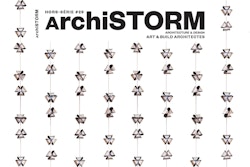Archistorm - ArtBuild Special Edition
Write

Buildings, districts and cities are living organisms.
If this analogy between the built and natural environments is the common thread running through our conceptual approach, innovation is its physical manifestation, seen in each new building we design.
Innovation means doing things differently so that we do them better. It means creating value, transcending reality, exploring what is possible, and building bridges to the future. Innovation is inseparable from progress.
Most importantly, innovation is a duty—and a commitment. Beyond our responsibility as technical experts, we have a responsibility to leave a healthily constructed heritage to future generations: this is our responsibility to society.
What we design has a direct impact on our environment through the materials we use, the means required to transform them, the energy used to run buildings, the way we organise land use and - from a global point of view - what we take from the earth and what we give back to it.
Our designs also have an impact on people’s lives, their wellbeing, their behaviour, their sense of fulfilment, and the way they interact with one another. In short, everything that social and cultural structures rely on.
So innovation is first and foremost a conviction. But what form can it take in architecture?
Addressing form without addressing content is as simplistic as considering form and content as opposites when in fact they are inseparable. In reality, form cannot exist without the process that gives rise to it.
This means that an architectural project embodies a large quantity of carefully processed information, constraints to be dealt with, and parameters to be considered. A large team of people fuel the project, informing the design with their expertise, enthusiasm and intelligence. In this regard, the process which transforms this information into a project via interaction between people is fundamental. Without it, the project can neither be conceived nor constructed.
Innovation thus also means creating the necessary conditions for the process of transforming information and ideas through collective intelligence, which has become our hallmark.
This collective intelligence is the force that keeps our firm alive, and is developed through the potential of each contributor. Its future is nurtured on the fertile ground of our ideas, and constantly renews itself.
The digital revolution offers us a new realm of possibilities. Technology is first an opportunity to create added value which is beneficial to humans.
The more technology carries out complex tasks, the more it frees us to focus on what is essential: creativity, learning, sharing, cooperation, altruism, and solidarity.
It also includes the notion of “augmented intelligence”.
Never have people been in such close contact with one another. Never has access to diversity been so broad. Never has knowledge been so accessible and so widely shared. Technology creates links and catalyses intelligence.
The realm of possibility requires an ability to think outside the box, to create the necessary conditions for dealing with complexity, accepting other people, and doing things differently and better—better for humans, and better for the Earth.
If the possibilities are so numerous, it means there is no single truth in architecture, but instead “approaches that get as close as possible to the truth”. In other words, complexity also gives rise to emotion, surprise, and the unexpected. We don’t create added value per se, but rather the necessary conditions for added value to be created.
As we work, through our ad hoc interventions we try collectively to create a better world. We try to perform “sustainable acupuncture” to care for the living organism that is the city.
For example we don’t set out to design “a hospital” or “a shopping centre”. We first design a “living environment” that lends itself to wellbeing and individual and collective self-fulfilment, always taking care to improve its ecological footprint.
These may be places adapted to the practice of medicine or commerce, but most importantly they are spaces adapted to what these professions are likely to become in future, in the light of technological and social change. Innovation also means anticipation.
So what matters is not so much the building as what it contains. What matters is the human activity that takes place there and the processes that give rise to it. We call it “the architecture inside”. It is an approach to architecture that is more feminine than masculine, it lays more emphasis on the informal than the formal. It is an approach which enables conversation, empathy, intuition, perception and emotion to become the main vectors for our creativity.